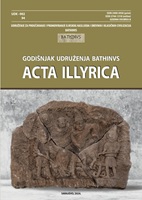Lektisternij: bogovi za stolom u antičkom Rimu
Lectisternium: Gods at the Table in Ancient Rome
Author(s): Drago Župarić, Seada BrkanSubject(s): Archaeology, Cultural history, Social history, Ancient World, Sociology of Religion, History of Religion
Published by: Udruženje za proučavanje i promoviranje ilirskog naslijeđa i drevnih i klasičnih civilizacija “BATHINVS”
Keywords: lectisternium; plagues; gods; propitiatory rites; religion; ancient Rome; social solidarity;
Summary/Abstract: The paper titled “Lectisternium: Gods at the Table in Ancient Rome” explores the ancient Roman ritual of lectisternium, which involved setting up tables and offering food to the gods as an act of hospitality and a plea for divine favor. This ritual was crucial in times of crisis, such as epidemics and wars. The paper is structured into three sections. 1) Definition and Historical Beginnings of Lectisternium. The lectisternium was first practiced in Rome at the end of the 4th century BC, following an epidemic of the plague in 399 BC. The ritual involved placing statues of the gods on couches next to tables with food and drink, creating the illusion of their presence at a feast. 2) Applications, Characteristics, and Duration of the Ritual. The lectisternium was performed during times of great danger for the people and the state. The organization of this ritual was public and included all citizens. The ritual lasted seven to eight days. 3) The Gods and Their Roles in the Ritual of Lectisternium. The first recorded lectisternium was dedicated to Apollo, Latona, Diana, Hercules, Mercury, and Neptune. Later, the gods were changed to include Jupiter and Juno. This ritual gradually evolved to include other deities such as Fortuna, Saturn, and Juno Regina. The Reconciliatory Nature of the Lectisternium. The lectisternium was not only a religious ritual but also a social event that promoted solidarity and unity among the Romans. During the ritual, all disputes were temporarily forgotten, highlighting the reconciliatory nature of the ceremony. The Gradual Decline of the Lectisternium with the Advent of Christianity. With the advent of Christianity and its monotheistic rituals, the practice of the lectisternium gradually disappeared. New religious customs replaced the old ones, reflecting changes in the social and religious norms of Rome. In conclusion, the paper highlights that the lectisternium was a significant ritual in ancient Rome, symbolizing the Romans’ desire for harmony with the divine forces. Through historical analysis, the paper depicts the evolution and decline of this practice and emphasizes its impact on the social and religious aspects of Roman culture. The ritual promoted unity and solidarity among citizens and served as a platform for public expressions of repentance and the restoration of social order. With the changes brought by new religious paradigms, the lectisternium lost its significance, but its role in shaping Roman society remains unquestionable.
Journal: Godišnjak Udruženja BATHINVS “Acta Illyrica”
- Issue Year: 8/2024
- Issue No: 8
- Page Range: 17-33
- Page Count: 17
- Language: Bosnian

